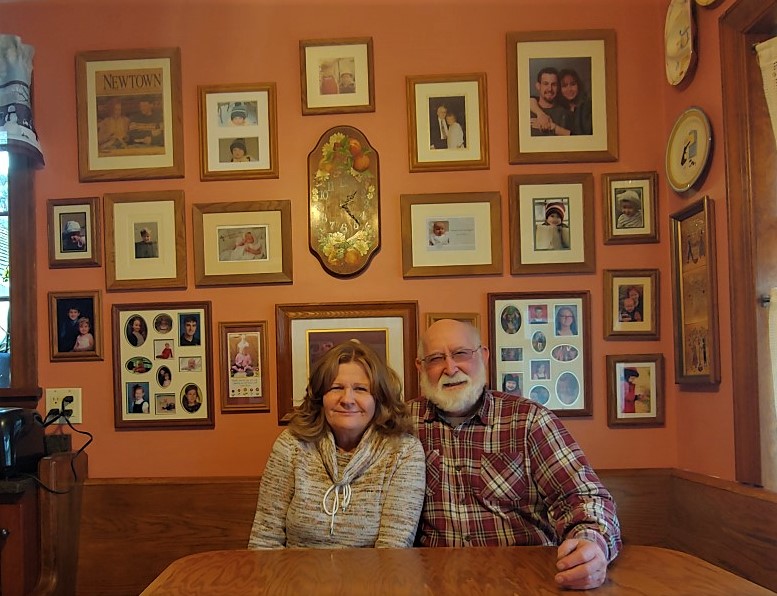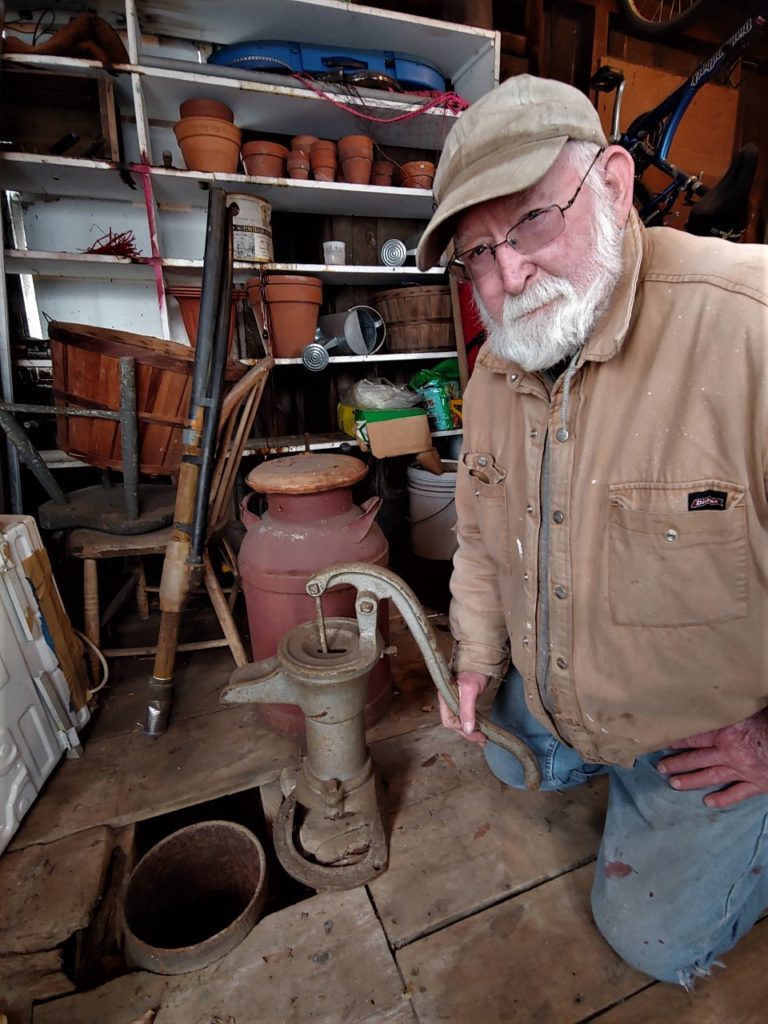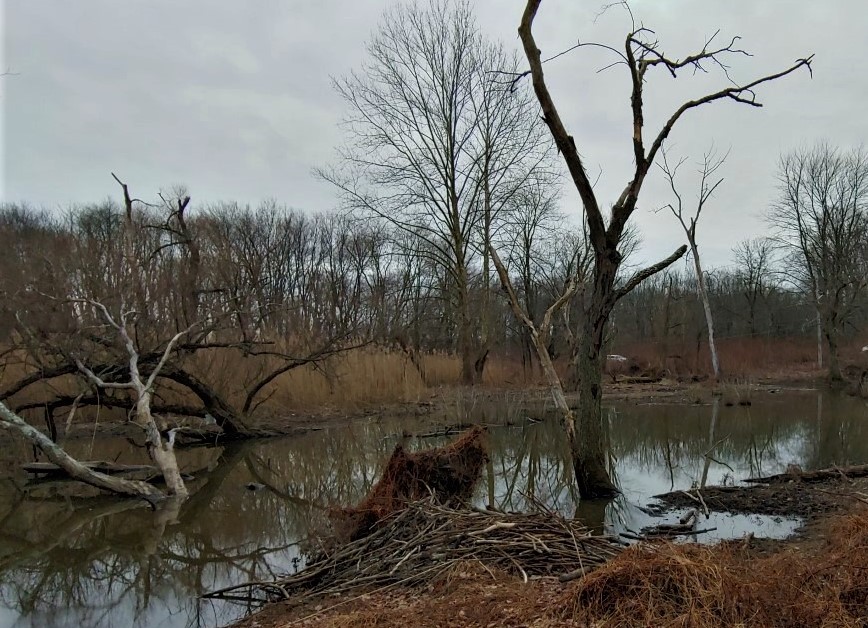The long lost story of David’s Well.
Jane and Wayne Nelson had no idea what they were buying when they took possession of a 19th Century farm a few miles north of Bristol in 1975. A clue emerged when they dug up a blue glass bottle engraved with “Mystic Waters from David’s Well”. A small outbuilding had a long capped pump called David’s Well. But “Mystic Waters”. Huh? It left them wondering the past 45 years. Then I arrived.

I knocked two weeks ago after learning of the well from local historian Clarence King. Jane and Wayne’s two-story, expanded home hugs tightly to busy Green Lane at Mill Creek Road near Truman High School in Bristol Township. The house is a vestige of post-Colonial days when most of Lower Bucks was farmland. The Nelsons graciously welcomed me into their sunny kitchen where we enjoyed a chat over fresh bakery goods and coffee. I felt a bit like Henry Gates as I spread out documents on the table to discuss the history of David’s Well.
The story begins with Daniel B. Taylor of Lower Makefield in 1854. A visitation by spirits directed him to buy property on the upper edge of Pidgeon’s Swamp at the dirt road intersection of Green and Mill Creek. Named for Joseph Pidgeon of Falls, the swamp was the largest of three – Biding’s, Green’s and Pidgeon’s – that once extended from Bristol to Falls and covered more than 1,000 acres. The lower end of Pidgeon’s was where the famous Bath Springs spa stood in the 1700s.

Daniel built a brick house, then set to work drilling a well. Spirits told him to bore down 101 feet 6 inches to remarkable medicinal waters. Sixty feet down Taylor hit bedrock. He continued boring through hard, blue stone to reach a void of clear water at exactly 101 feet 9 inches. Through the opening, Daniel dropped an 8-inch-wide iron casing. From a pump handle, he drew water analyzed by a Philadelphia physician. Results showed it was rich in iron, sulphur, lime, magnesium, potassium and silica – “chalybeate” – the same tonic dispensed at Bath Springs a century earlier.
Danny built a one-room, frame building over the pump with a door opening to Mill Creek Road. From there he sold “Mystic Waters from David’s Well” at 50 cents per bottle (about $20 today). Customers lined up. Taylor capitalized by constructing on Green Lane a short distance away “The Healing Institute at David’s Well” catering to invalids and pleasure seekers. An ad in Camden’s New Republic newspaper touted David’s Well water as “the great Diuretic, Tonic and Alternative remedy of the age, holding in solution of iron and other valuable compounds as one of the best known remedies for Kidney Diseases, Dyspepsia, Nervousness, Liver Complaints, Catarrhal Affections, Consumption, in its early stages, Diabetes, and General Debility. It purifies and enriches the blood, increases the appetite, promotes digestion, stimulates secretions and vitalizes the nervous system. It is highly recommended by physicians and the testimonials of invalids reveal its secret powers.”

For several years business bloomed. The Young Ladies Walking Club of Bristol hiked 6 miles round trip to slake their thirst at the well. An elderly customer vouched the water seemed like “both meat and drink” to her.
Daniel Taylor’s good tidings lasted about 10 years. As sales tapered off, he sold the farm to Benjamin Lloyd in 1871. Seven years later, the Health Institute burned down. Eventually, the Booz family took possession for the next 100 years. In the 1940s, the family capped the well after a cook mistakenly used well water rather than spring water for coffee. It was laden with sulphate and carbonate of magnesia. The family left one-by-one from the dinner table in haste.
Widow Emma Booz in 1975 sold the farm to the Nelsons who have enjoyed raising their family on the property with a backyard leading down a long, grassy slope to Black Ditch Creek and the remains of Pidgeon’s Swamp. It’s there that wildlife including blue herons, foxes, deer and beavers thrive. Wayne Nelson, a carpenter who works restoring historic homes on Radcliffe Street in Bristol, built a backyard tree house like no other for his kids.
Wayne led me into the well house to see David’s Well. A detached pump handle and a protruding iron pipe in the floor remained. Wayne once dropped a line into the pipe, coming to rest 60 feet down. The two of us walked his acreage for an hour down to Black Ditch Creek, looking mighty mystical in its winter scape. As to what’s mystical about living near the well, the couple laughed. “No, no ghosts,” Jane chimed in. With a twinkle and a mirthful grin however, Wayne said a 5-legged calf with 6 hooves was born on the farm back in the day. Weird.
Sources include “They Took to the Waters” by Harry B. Weiss and Howard R. Kemble published in the Past Times Press based in Trenton, 1962, and “The History of Bucks County” by W.W.W. Davis published in 1905. A note of appreciation to historian Clarence King who will present a history of Silver Lake and Bath Springs on Saturday (Feb. 15) at 7 p.m. at the Silver Lake Nature Center, Bath Road, Bristol Township.

